
HerbbookforFacilitatorsandsmallscales
farmers
Mahlathini Development Foundaon has introduced planng of herbsin the garden as part of the
Climate smart agriculture pracce for good crop management, which is under nger four of Five Finger
principles. All learning groups from dierent villages were introduced to dierent kinds of herbs and
were also taught how to implement herbs in their meals/how to use some of the herbs. MDF decided
to have a herb handbook forfarmers to refer to the uses of all theherbs they have in their gardens.
The uses dier, some herbs have medicinal benets, and some can be implemented in the kitchen.
1.Flat leave/curly leave parsley
Parsley is a biannual plant, it grows all throughout the year in Limpopo, even in extreme heat it thrives.
Health benets of parsley:
•Parsley does contain a good number of avonoids, which are dietary anoxidants (vitamin C,
carotenoids and avonoids (myricen and apigenin).) that assist in lower the risk of signicant
health disorders such as diabetes, stroke, heart disease, and cancer.
•Parsley contains 0% cholesterol and fats, and it is rich in anoxidants, nutrients, minerals, and
Fiber.
• Thisherb can help to control cholesterol levels and mayreduce the risk of cancers and free
radical-mediated harm. The compounds found in parsley helps prevent oxidave damage to
cells and reduce the risk of chronic diseases.
•Vitamin C is also important for wound healing and may support bone health by promong the
producon of collagen.
•Vitamin K is also important for bone health. Carotenoids are anoxidants that can be
converted to vitamin A which, helps protect the eyes and promote healthy vision.
Uses of parley: Parsley can be used for culinary and medicinal purposes.
Parsley can be used fresh from the garden/shop, or it can be dried and used. Parsley has been used to
treat condions like high blood pressure, allergies, and inammatory diseases.Itis also anexcellent

complement to dishes due to its contribuon of avour and aroma. Parley can be dried, dried parsley
may be higher in anoxidants than fresh sprigs. In fact, one study found that the dried herb had 17
mes more anoxidant content than its fresh counterpart.
Culinary uses of parsley include the following.
•It can be used to garnish food.
•It can be used to make pesto’s.
•You can use the dried version as an ingredient in various recipes. It can enhance the avour of
soups, stews, and tomato sauces.
•Finely chop the stems can be added to potato salad for an extra crunch.
2.Coriander
Coriander is an annual plant. In Limpopo coriander thrives in winter season, it doesn’t grow well in the
extreme weather of Limpopo. Coriander can be used both as a herb and a spice. Itsdry fruits and
seeds, which are also known as coriander, are used to avour many foods, parcularlysausages and
wors.
Health benets of Coriander:
•Coriander seeds, extract, and oils may all help lower blood sugar.
•Coriander seedsare said reduce blood sugarby promong enzyme acvity that helps remove
sugar from the blood.
•Coriander oers several anoxidants, which are shown to ght inammaon in your body.
•Coriander contains anmicrobial compounds that may help ght certain infecons
andfoodborne illnesses.
•Coriander contains anoxidants that mayprotect your skin from aging and sun damage. It may
also help treat mild skin rashes.
•Coriander is a good source ofFiber,calcium,magnesium,manganese, andiron. It has
elevencomponentsofessenal oilsand six types of acids, includingascorbic acidor vitamin
C, each having several benecial properes.

•The disinfectant, detoxifying, ansepc, anfungal, and anoxidant properes of coriander
may prove to be ideal for clearing upskin disorderssuch as eczema, dryness, and fungal
infecons.
Coriander seed tea has the following benets:
•Reduces pimples.
•Aid digeson.
•Andiabec
•Has anbacterial properes.
•Prevents anaemia.
•Treats conjuncvis
•Prevents menstruaon irregularies.
Culinaryuses of coriander: Whole seeds can be added to baked goods, pickled vegetables,
rubs,roasted vegetables, and cooked lenl dishes. They can be ground for use in pastes and doughs.
Fresh leaves can be used in salads, to garnish food.
3.Fennel
Fennel is recognized by its white bulb and long green stalks. It is related to other stalk vegetables, such
as celery andparsnips. The enre fennel plant is edible, including the bulb, seeds, stalk and leaves.
Health benets of fennel:
•Fennel seeds are rich in avonoid anoxidants, and they contain a concentrated source of
micronutrients.
•The seeds are also used to make fennel essenal oil, rst by crushing them and then using a
process called steam disllaon.Due to the calcium content, fennel can help maintain bone
strength and health.
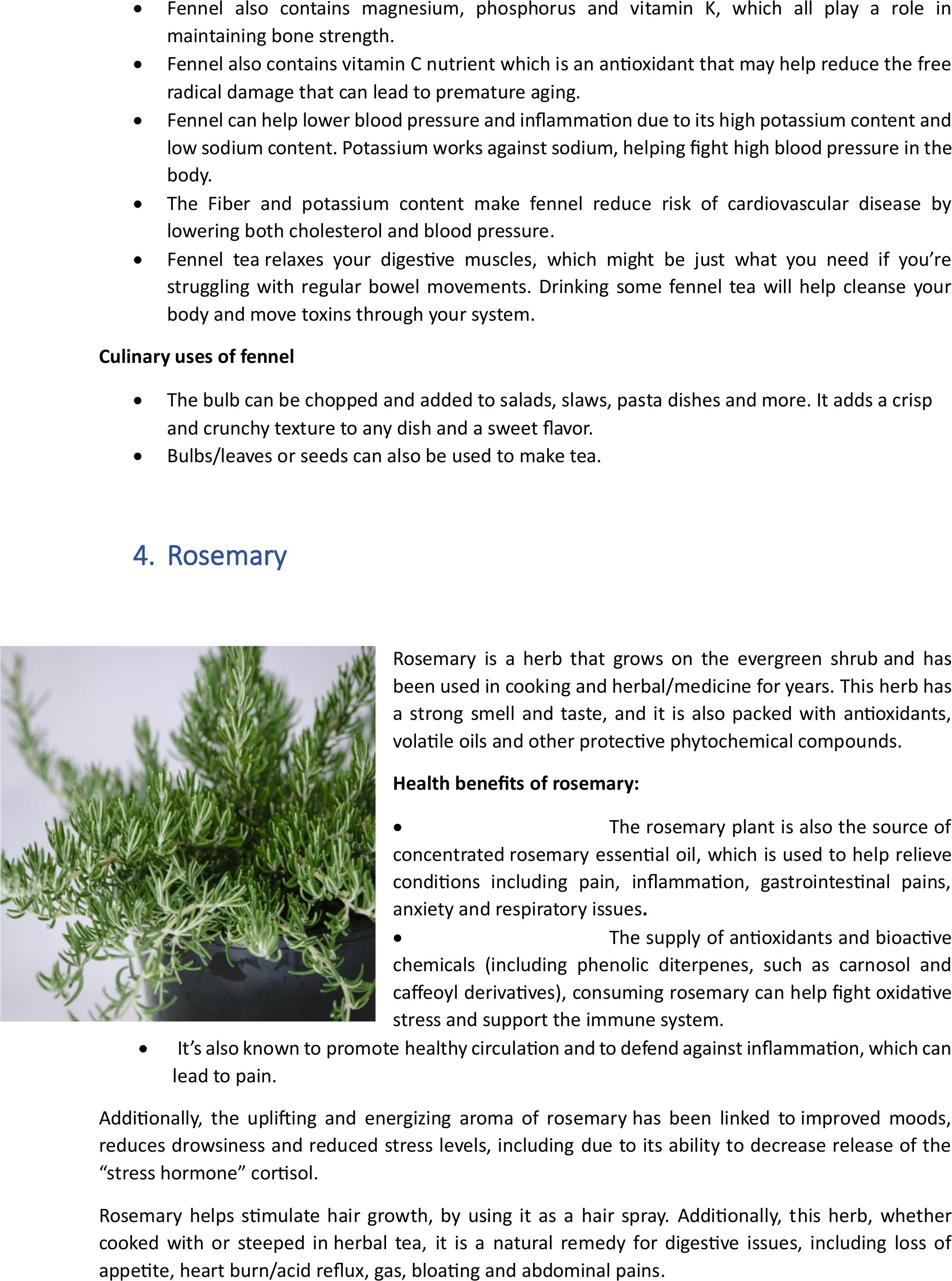
•Fennel alsocontains magnesium, phosphorus and vitamin K, which all play a role in
maintaining bone strength.
•Fennel also contains vitamin C nutrient which is an anoxidant that may help reduce thefree
radical damage that can lead to premature aging.
•Fennel can help lower blood pressure and inammaon due to its high potassium content and
low sodium content. Potassium works against sodium, helping ghthigh blood pressurein the
body.
•The Fiber and potassium content make fennel reduce risk ofcardiovasculardisease by
lowering both cholesterol and blood pressure.
•Fennel tearelaxes your digesve muscles, which might be just what you need if you’re
struggling with regular bowel movements. Drinking some fennel tea will help cleanse your
body and move toxins through your system.
Culinary uses of fennel
•The bulb can be chopped and added to salads, slaws, pasta dishes and more. It adds a crisp
and crunchy texture to any dish and a sweet avor.
•Bulbs/leaves or seeds can also be used to make tea.
4.Rosemary
Rosemary is a herb that growson the evergreen shruband has
been used in cooking and herbal/medicine for years. This herb has
a strong smell and taste, and it is also packed with anoxidants,
volale oils and other protecve phytochemical compounds.
Health benets of rosemary:
•The rosemary plant is also the source of
concentratedrosemary essenal oil, which is used to help relieve
condions including pain, inammaon, gastrointesnal pains,
anxiety and respiratory issues.
•The supply of anoxidants and bioacve
chemicals (including phenolic diterpenes, such as carnosol and
caeoyl derivaves), consuming rosemary can helpghtoxidave
stress and support the immune system.
• It’s also known topromotehealthy circulaon and to defend against inammaon, which can
lead to pain.
Addionally, the upliing and energizing aroma of rosemaryhas been linked toimproved moods,
reduces drowsiness and reduced stress levels, including due to its ability to decrease release of the
“stress hormone” corsol.
Rosemary helps smulate hair growth, by using it as ahair spray.Addionally, this herb, whether
cooked with or steeped inherbal tea, it is a natural remedy for digesve issues, including loss of
appete, heart burn/acid reux, gas, bloang and abdominal pains.
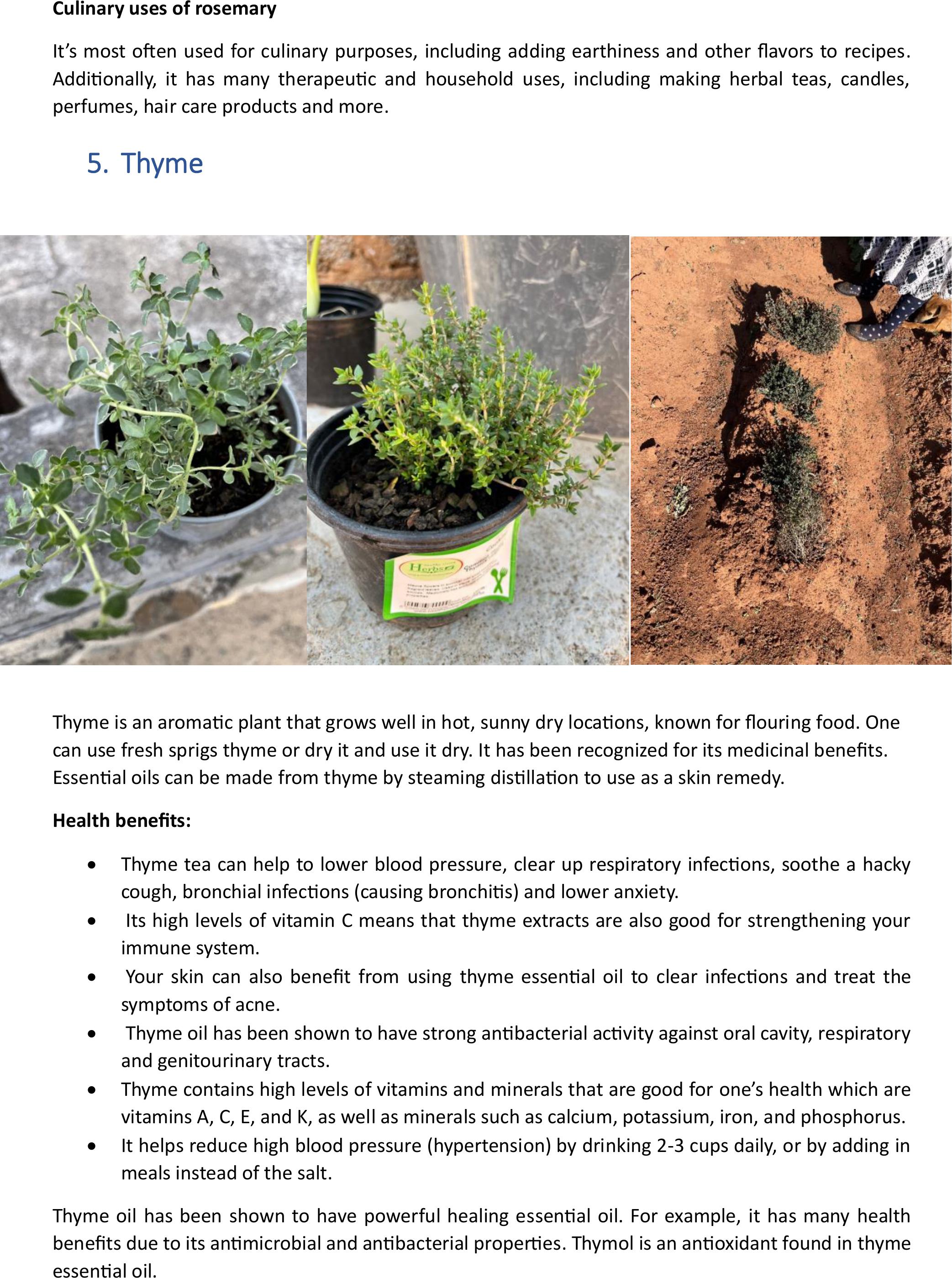
Culinary uses of rosemary
It’s most oen used for culinary purposes, including adding earthiness and other avorsto recipes.
Addionally, it has many therapeucand household uses, including making herbal teas, candles,
perfumes, hair care products and more.
5.Thyme
Thyme is an aromac plant that grows well in hot, sunny dry locaons, known for ouring food. One
can use fresh sprigs thyme or dry it and use it dry. It has been recognized for its medicinal benets.
Essenal oils can be made from thyme by steaming disllaon to use as a skin remedy.
Health benets:
•Thyme tea can help to lower blood pressure, clear up respiratory infecons, soothe a hacky
cough, bronchial infecons (causing bronchis) and lower anxiety.
• Its high levels of vitamin C means that thyme extracts are also good for strengthening your
immune system.
• Your skin can also benet from using thyme essenal oil to clear infecons and treat the
symptoms of acne.
• Thyme oil has been shown to have strong anbacterial acvity against oral cavity, respiratory
and genitourinary tracts.
•Thyme contains high levels of vitaminsand minerals that are good forone’s health which are
vitamins A, C, E, and K, as well as minerals such as calcium, potassium, iron, and phosphorus.
•It helps reduce high blood pressure (hypertension) by drinking 2-3 cups daily, or by adding in
meals instead of the salt.
Thyme oil has beenshown to have powerful healing essenal oil. For example, it has manyhealth
benets due to its anmicrobial and anbacterial properes. Thymol is an anoxidant found in thyme
essenal oil.
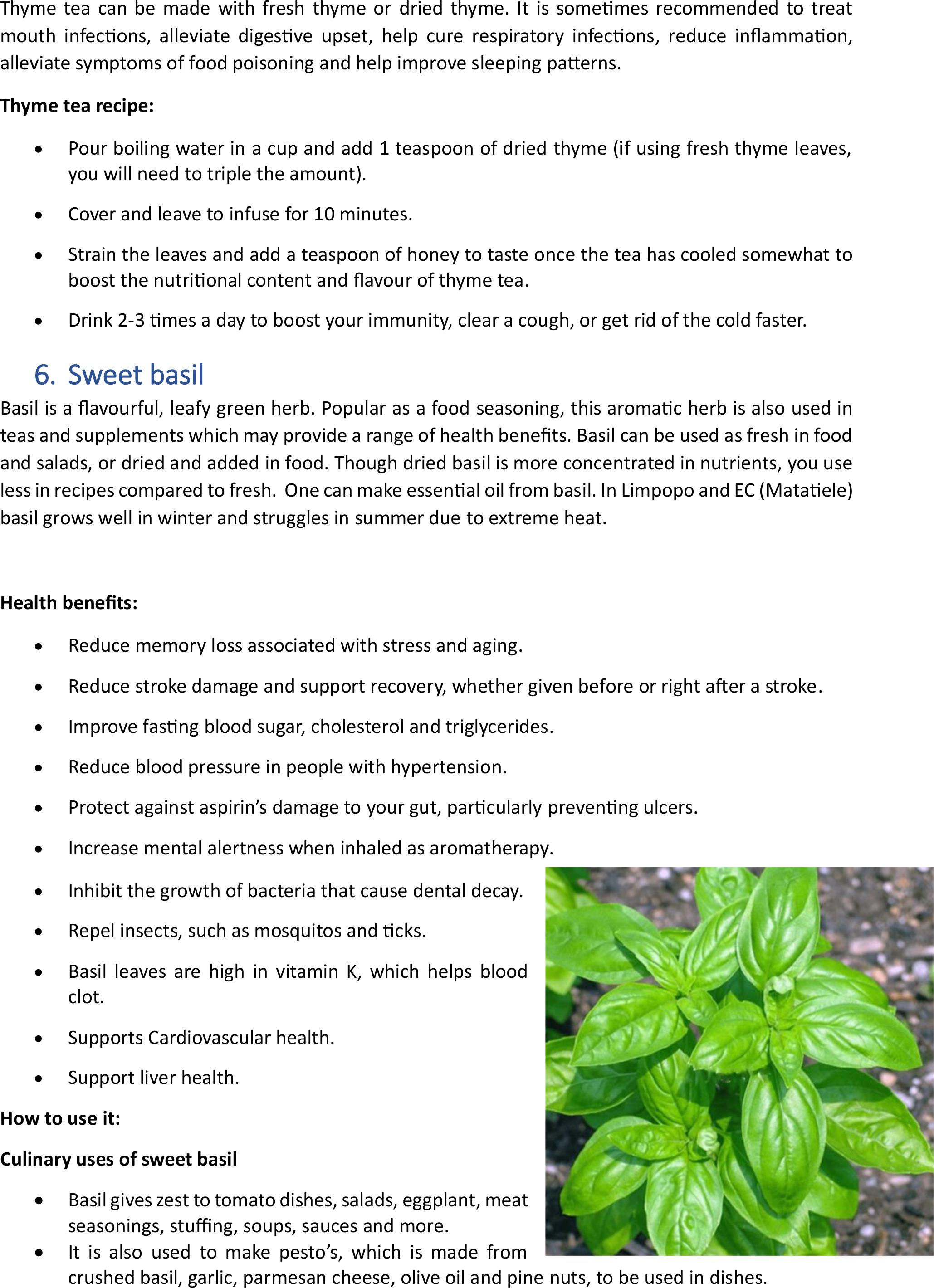
Thyme tea can be made with fresh thyme or dried thyme. It is somemes recommended to treat
mouth infecons, alleviate digesve upset, help cure respiratory infecons, reduce inammaon,
alleviate symptoms of food poisoning and help improve sleeping paerns.
Thyme tea recipe:
•Pour boiling water in a cup and add 1 teaspoon of dried thyme (if using fresh thyme leaves,
you will need to triple the amount).
•Cover and leave to infuse for 10 minutes.
•Strain the leaves and add a teaspoon of honey to taste once the tea has cooled somewhat to
boost the nutrional content and avour of thyme tea.
•Drink 2-3 mes a day to boost your immunity, clear a cough, or get rid of the cold faster.
6.Sweet basil
Basil is a avourful, leafy green herb. Popular as a food seasoning, this aromac herb is also used in
teas and supplements which may provide a range of health benets.Basil can be used as fresh in food
and salads, or dried and added in food. Though dried basil is more concentrated in nutrients, you use
less in recipes compared to fresh. One can make essenal oil from basil. In Limpopo and EC (Mataele)
basil grows well in winter and struggles in summer due to extreme heat.
Health benets:
•Reduce memory loss associated with stress and aging.
•Reduce stroke damage and support recovery, whether given before or right aer a stroke.
•Improve fasng blood sugar, cholesterol and triglycerides.
•Reduce blood pressure in people with hypertension.
•Protect against aspirin’s damage to your gut, parcularly prevenng ulcers.
•Increase mental alertness when inhaled as aromatherapy.
•Inhibit the growth of bacteria that cause dental decay.
•Repel insects, such as mosquitos and cks.
•Basil leaves are high in vitamin K, which helps blood
clot.
•Supports Cardiovascular health.
•Support liver health.
How to use it:
Culinary uses of sweet basil
•Basil gives zest to tomato dishes, salads, eggplant, meat
seasonings, stung, soups, sauces and more.
•It is also used to make pesto’s, which is made from
crushed basil, garlic, parmesan cheese, olive oil and pine nuts, to be used in dishes.
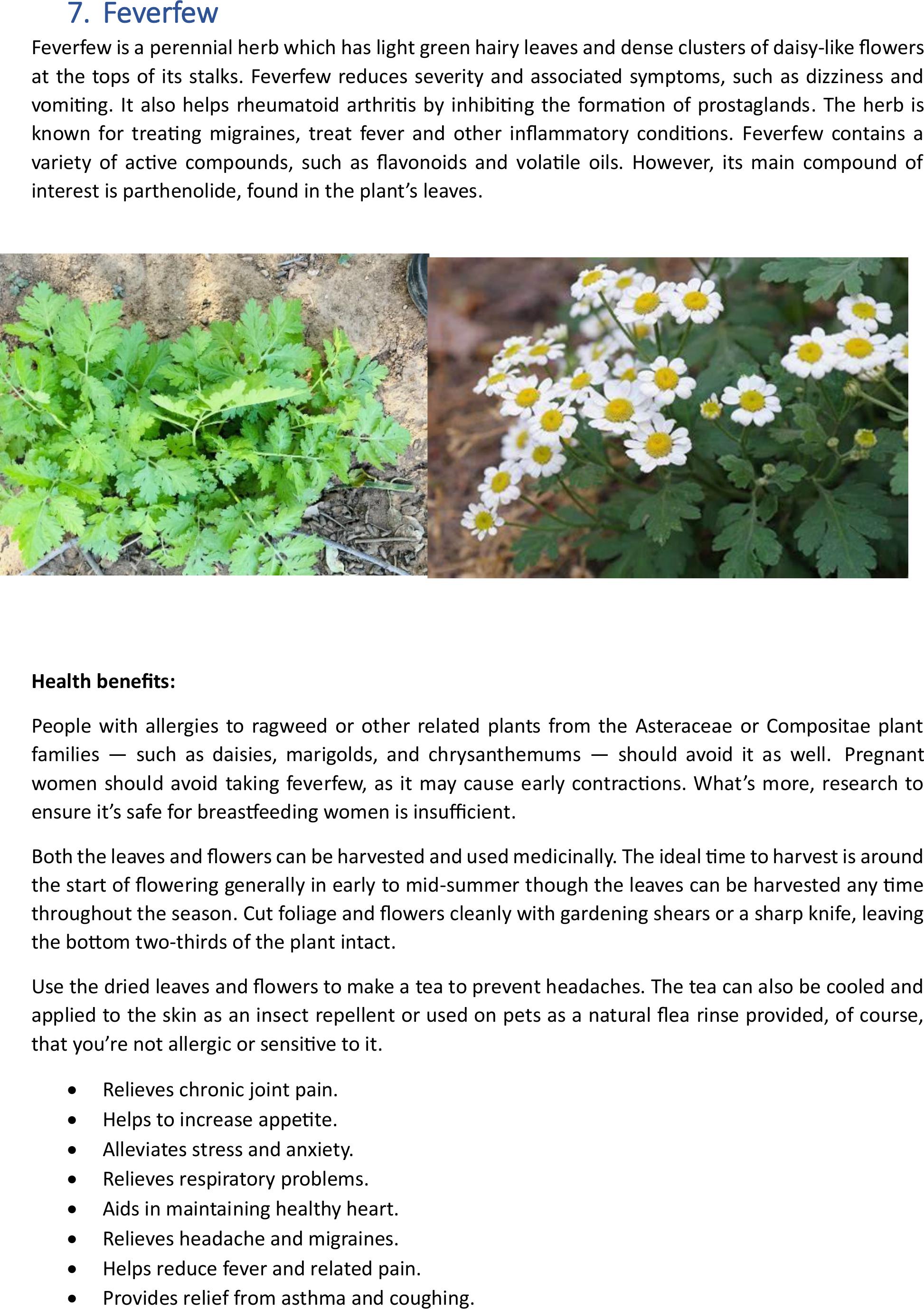
7.Feverfew
Feverfew is aperennial herb which has light green hairy leaves and dense clusters of daisy-like owers
at the tops of its stalks. Feverfew reduces severity and associated symptoms, such as dizziness and
voming. It also helps rheumatoid arthris by inhibing the formaon of prostaglands. The herb is
known for treang migraines, treat fever and other inammatory condions. Feverfewcontains a
variety of acve compounds, such as avonoids and volale oils. However, its main compound of
interest is parthenolide, found in the plant’s leaves.
Health benets:
People with allergies to ragweed or other related plantsfrom the Asteraceae or Compositae plant
families— such as daisies, marigolds, and chrysanthemums — should avoid it as well.Pregnant
women should avoid taking feverfew, as it may cause early contracons. What’s more, research to
ensure it’s safe for breaseeding women is insucient.
Both the leaves and owers can be harvested and used medicinally. The ideal me to harvest isaround
the start of owering generally in early to mid-summer though the leaves can be harvested any me
throughout the season. Cut foliage and owers cleanly with gardening shears or a sharp knife, leaving
the boom two-thirds of the plant intact.
Use the dried leaves and owers to make a tea to prevent headaches. The tea can also be cooled and
applied to the skin as an insect repellent or used on pets as a natural ea rinse provided, of course,
that you’re not allergic or sensive to it.
•Relieves chronic joint pain.
•Helps to increase appete.
•Alleviates stress and anxiety.
•Relieves respiratory problems.
•Aids in maintaining healthy heart.
•Relieves headache and migraines.
•Helps reduce fever and related pain.
•Provides relief from asthma and coughing.

•Helps treat skin condions and irritaon.
8.Dill
Dill is a plant that has slender stems with alternang so leaves and brown, at, oval seeds. The
leaves have a sweet, grassy avour and seeds are more aromac.
Nutrient value: Dill contains the following nutrients.
•Vitamin C - is vital for your immune system and helps with bone formaon, wound healing,
and metabolism.
•Manganese -essenal mineral that supports normalfunconing of your brain, nervous
system, and metabolism of sugar and fat.
•Vitamin A- helpswith maintaining vision and supporng a healthy immune system.
•Folate and Iron
Dill is rich in anoxidants. Anoxidants help protect cells against damage caused by unstable
molecules. The rst anoxidants are theavonoids, it is associated with areduced risk of heart
disease, stroke, and some forms of cancer. It is also saidthat they may also play an important role in
brain health.Terpenoids found in essenal oils made of dill herb may protect against liver, heart,
kidney, and brain diseases. Tannins, which is responsible for bierness in many plant foods, tannins
have been shown to have potent anoxidant properes, as well as anmicrobial eects.
Culinary uses: Dill is commonly used to elevate the avour of various dishes. It’s oen paired with
salmon, potatoes, and yogurt-based sauces. The tea can also be cooled and applied to the skin as an
insect repellent or used on pets as a natural ea rinse provided, of course, that you’re not allergic or
sensive to it. Dill tea can help to improve digeson and relieve stomach cramps. It is also a diurec,
which means it can help to reduce water retenon. Dill tea is also thought to have detoxifying
properes and be benecial for the respiratory system. The tea can be made from seeds or leaves
and boiling water, adding honey.

9.Lemon grass
Lemon grass tastes and smells like lemon but is sweeter and milder. It has been used to treat lots of
health issues and condions.Dried or fresh, lemongrass boasts has plenty of benecial medicinal
properes such as an-inammatory, analgesic, andepressant, ansepc, anpyrec, anbacterial,
astringent, anfungal, carminave, febrifuge, diurec, galactagogue, sedave, inseccidal, an-cancer,
and an-aging properes.
Health benets:
•Lemongrass possesses potent pain-relieving and an-inammatory properes that help to
treat rheumasm,arthris, gout, osteoarthris, and other kinds of the joint pain.
•Lemongrass is an excellent sourceof anoxidants that help to decrease the risk ofcancer by
eliminang free radicals in the body.
•Lemongrass is renowned for its incredible anfungal and anbacterial properes that help the
body to eecvely ght bacteria and viruses and thus deal with cold and u symptoms faster.
•Lemongrass is also eecve in treang the muscle pain and headaches related to colds or u.
It’s also helpful in breaking down phlegm and mucus build-up, thus resolving breathing issues.
•Drinking lemongrass tea at least once a day helps detoxify and cleanse the whole body.Thanks
to its diurec properes, lemongrass helps to ush out harmful toxins, eliminate uric acid, and
lower the bad cholesterol levels by increasing the quanty and frequency of urinaon.
•Lemongrass tea can aid in purifying the pancreas, bladder, and liver, as well as in elevang
blood circulaon that’s vital for overall health.
•The an-atherosclerosisand an-cholesterol abilies of lemongrass helpto decrease the
cholesterol absorpon from the intesne.
•Lemongrass can help to treat numerous digesve health issues, including conspaon,
indigeson, heartburn, bloang, diarrhea, atulence, voming, stomach spasms, cramps, and
in some cases nausea.
•Citronella found in lemongrass has a calming eect on the body and mind and thus helps you
get a beer-quality sleep.
•Lemongrass is great forpeople with type-2diabetes. Lemongrass tea helps tomaintain opmal
levels of insulin and enhance the glucose tolerance in the body.
Nutrion benets
•Fiber
•Carbohydrate
•Vitamins A, B & C
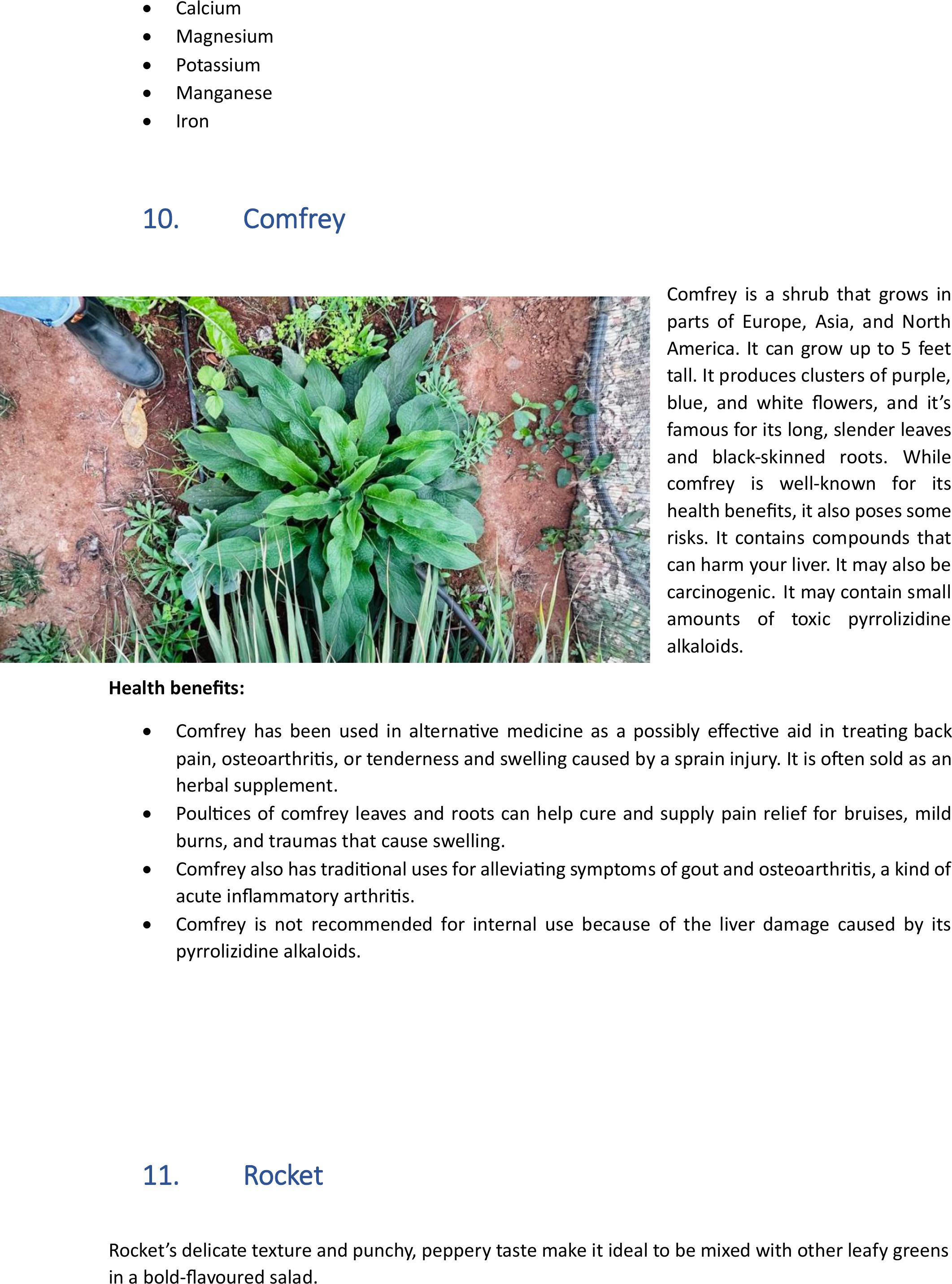
•Calcium
•Magnesium
•Potassium
•Manganese
•Iron
10.Comfrey
Comfrey is a shrub that grows in
parts of Europe, Asia, and North
America. It can grow up to 5 feet
tall. It produces clusters of purple,
blue, and white owers, and it’s
famousforits long, slender leaves
and black-skinned roots. While
comfrey is well-known for its
health benets, it also poses some
risks. It contains compounds that
can harm your liver. It may also be
carcinogenic.It may contain small
amounts of toxic pyrrolizidine
alkaloids.
Health benets:
•Comfrey has been used in alternave medicine as a possibly eecve aid in treangback
pain,osteoarthris, or tenderness and swelling caused by a sprain injury. It is oen sold as an
herbal supplement.
•Poulces of comfrey leaves and roots can help cure and supply pain relief for bruises, mild
burns, and traumas that cause swelling.
•Comfrey also has tradional uses for alleviang symptoms of gout and osteoarthris, a kind of
acute inammatory arthris.
•Comfrey is not recommended for internal use becauseof the liverdamage caused by its
pyrrolizidine alkaloids.
11.Rocket
Rocket’s delicate texture and punchy, peppery taste make it ideal to be mixed with other leafy greens
in a bold-avoured salad.
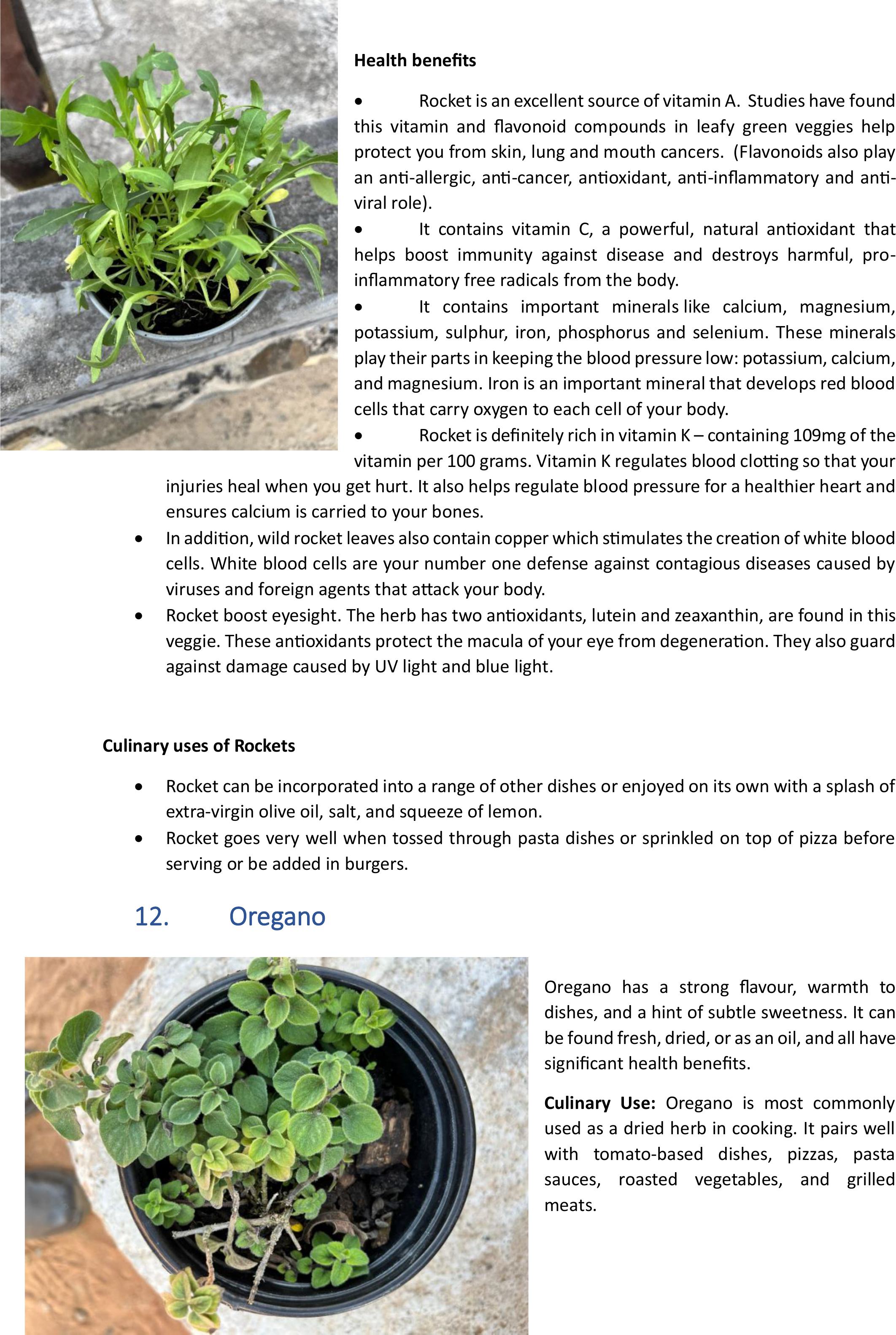
Health benets
•Rocket is an excellent source of vitaminA. Studies have found
this vitamin and avonoidcompounds in leafy green veggies help
protect you from skin, lung and mouth cancers. (Flavonoids also play
an an-allergic, an-cancer, anoxidant, an-inammatory and an-
viral role).
•It contains vitamin C, a powerful, natural anoxidant that
helps boost immunity against disease and destroys harmful, pro-
inammatory free radicals from the body.
•It containsimportant mineralslike calcium, magnesium,
potassium, sulphur, iron, phosphorusand selenium. These minerals
play their parts in keepingthe blood pressure low: potassium, calcium,
and magnesium. Iron is an important mineral that develops red blood
cells that carry oxygen to each cell of your body.
•Rocket is denitely rich in vitaminK – containing 109mg of the
vitamin per 100 grams. Vitamin K regulates blood clong so that your
injuries heal when you gethurt. It also helps regulate blood pressure for a healthier heart and
ensures calcium is carried to your bones.
•In addion, wild rocket leaves also contain copperwhich smulates the creaon of white blood
cells. White blood cells are your number one defense against contagious diseases caused by
viruses and foreign agents that aack your body.
•Rocket boost eyesight.The herb has two anoxidants, lutein and zeaxanthin, are found in this
veggie. These anoxidants protect the macula of your eye from degeneraon. They also guard
against damage caused by UV light and blue light.
Culinary uses of Rockets
•Rocket can be incorporated into a range of other dishes or enjoyed on its ownwith a splash of
extra-virgin olive oil, salt, and squeeze of lemon.
•Rocketgoes very well when tossed through pasta dishes or sprinkled on top of pizza before
serving or be added in burgers.
12.Oregano
Oregano has a strong avour, warmth to
dishes, and a hint of subtle sweetness. It can
be found fresh, dried, or as an oil, and all have
signicant health benets.
Culinary Use:Oreganois most commonly
used as a dried herb in cooking. It pairs well
with tomato-based dishes, pizzas, pasta
sauces, roasted vegetables, and grilled
meats.
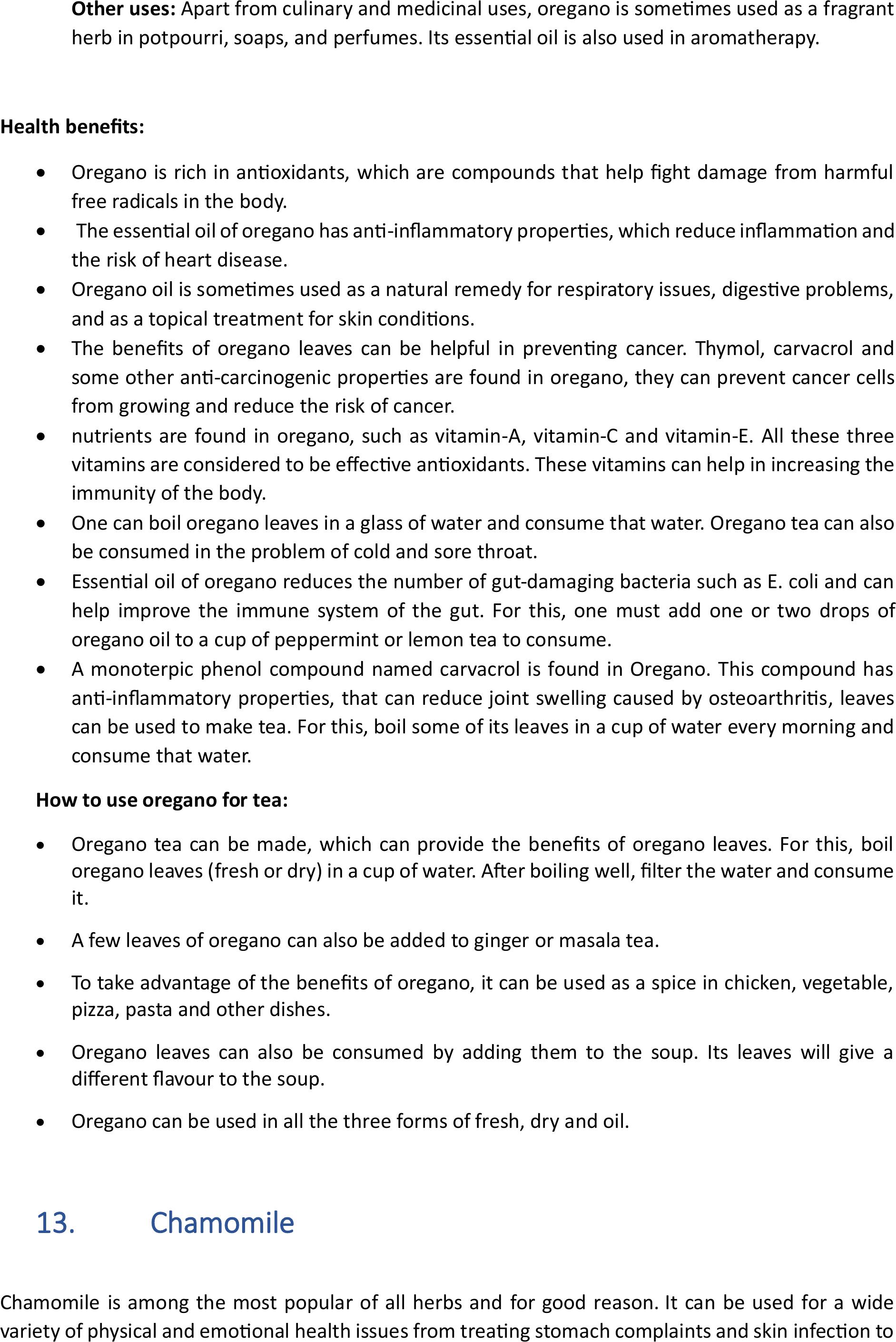
Other uses: Apart from culinary and medicinal uses, oregano is somemes used as a fragrant
herb in potpourri, soaps, and perfumes. Its essenal oil is also used in aromatherapy.
Health benets:
•Oregano is rich in anoxidants, which are compounds that help ghtdamage fromharmful
free radicals in the body.
•The essenal oil of oregano has an-inammatory properes, which reduce inammaon and
the risk of heart disease.
•Oregano oil is somemes used as a natural remedy for respiratory issues, digesve problems,
and as a topical treatment for skin condions.
•The benets of oregano leaves can be helpful in prevenng cancer. Thymol, carvacrol and
some other an-carcinogenicproperes are found in oregano, they can preventcancer cells
from growing and reduce the risk of cancer.
•nutrients are found in oregano, such as vitamin-A, vitamin-C and vitamin-E. All these three
vitamins are considered to be eecve anoxidants. These vitamins can help in increasing the
immunity of the body.
•One can boil oregano leaves in a glass of water and consume that water. Oregano tea can also
be consumed in the problem of cold and sore throat.
•Essenal oil of oregano reduces the numberof gut-damaging bacteria such as E. coli and can
help improve the immune system of the gut.For this, one must add one or two drops of
oregano oil to a cup of peppermint or lemon tea to consume.
•A monoterpic phenol compound named carvacrol is found in Oregano. This compound has
an-inammatory properes, that can reduce joint swelling caused by osteoarthris, leaves
can be used to make tea. For this, boil some of its leaves in a cup of water every morning and
consume that water.
How to use oregano for tea:
•Oregano tea can be made, which can provide thebenets oforegano leaves. For this, boil
oregano leaves (fresh or dry) in a cup of water. Aer boiling well, lter the water and consume
it.
•A few leaves of oregano can also be added to ginger or masala tea.
•To take advantage of the benets of oregano, it can be used as a spice in chicken, vegetable,
pizza, pasta and other dishes.
•Oregano leaves can also be consumed by adding them to the soup. Its leaves will give a
dierent avour to the soup.
•Oregano can be used in all the three forms of fresh, dry and oil.
13.Chamomile
Chamomile is among the most popular of all herbs andfor goodreason.It can be used for a wide
variety of physical and emoonalhealth issues from treang stomach complaints and skin infecon to
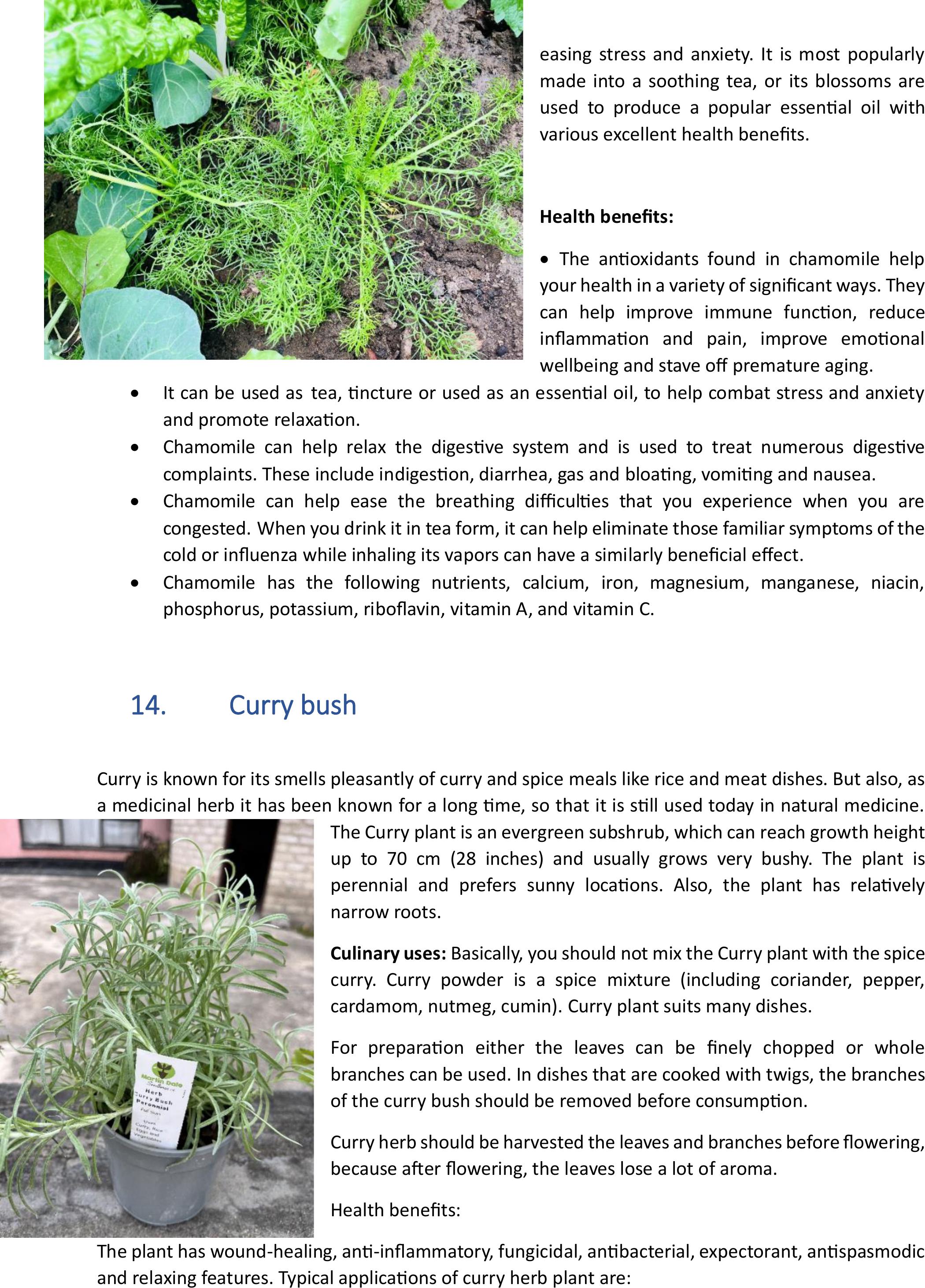
easing stress and anxiety. Itis most popularly
made into a soothing tea, or its blossoms are
used to produce a popular essenal oil with
various excellent health benets.
Health benets:
•The anoxidants found in chamomile help
your healthin a variety ofsignicant ways. They
can help improve immune funcon, reduce
inammaon and pain, improve emoonal
wellbeing and stave o premature aging.
•It can be used astea, ncture or used asan essenal oil, to help combat stress and anxiety
and promote relaxaon.
•Chamomile can help relax the digesve system and is used to treat numerous digesve
complaints.These include indigeson, diarrhea, gas and bloang, voming and nausea.
•Chamomile can help ease the breathing dicules that you experience when you are
congested.When you drink it in tea form, it can help eliminate those familiar symptoms of the
cold or inuenza while inhaling its vapors can have a similarly benecial eect.
•Chamomile has the following nutrients, calcium, iron, magnesium, manganese, niacin,
phosphorus, potassium, riboavin, vitamin A, and vitamin C.
14.Curry bush
Curry is known for its smells pleasantly of curry and spice meals like rice and meat dishes. But also, as
a medicinal herb it has been known for a long me, so that it is sll used today in natural medicine.
The Curry plant is an evergreen subshrub, which can reach growth height
up to 70 cm (28 inches) and usually grows very bushy. The plant is
perennial and prefers sunny locaons. Also, the plant has relavely
narrow roots.
Culinary uses: Basically, you should not mix the Curry plant with the spice
curry. Curry powder is a spice mixture (including coriander, pepper,
cardamom, nutmeg, cumin). Curry plant suits many dishes.
For preparaon either the leaves can be nely chopped or whole
branches can be used. In dishes that are cooked with twigs, the branches
of the curry bush should be removed before consumpon.
Curry herb should beharvestedthe leaves and branches before owering,
because aer owering, the leaves lose a lot of aroma.
Health benets:
The plant has wound-healing, an-inammatory, fungicidal, anbacterial, expectorant, anspasmodic
and relaxing features. Typical applicaons of curry herb plant are:
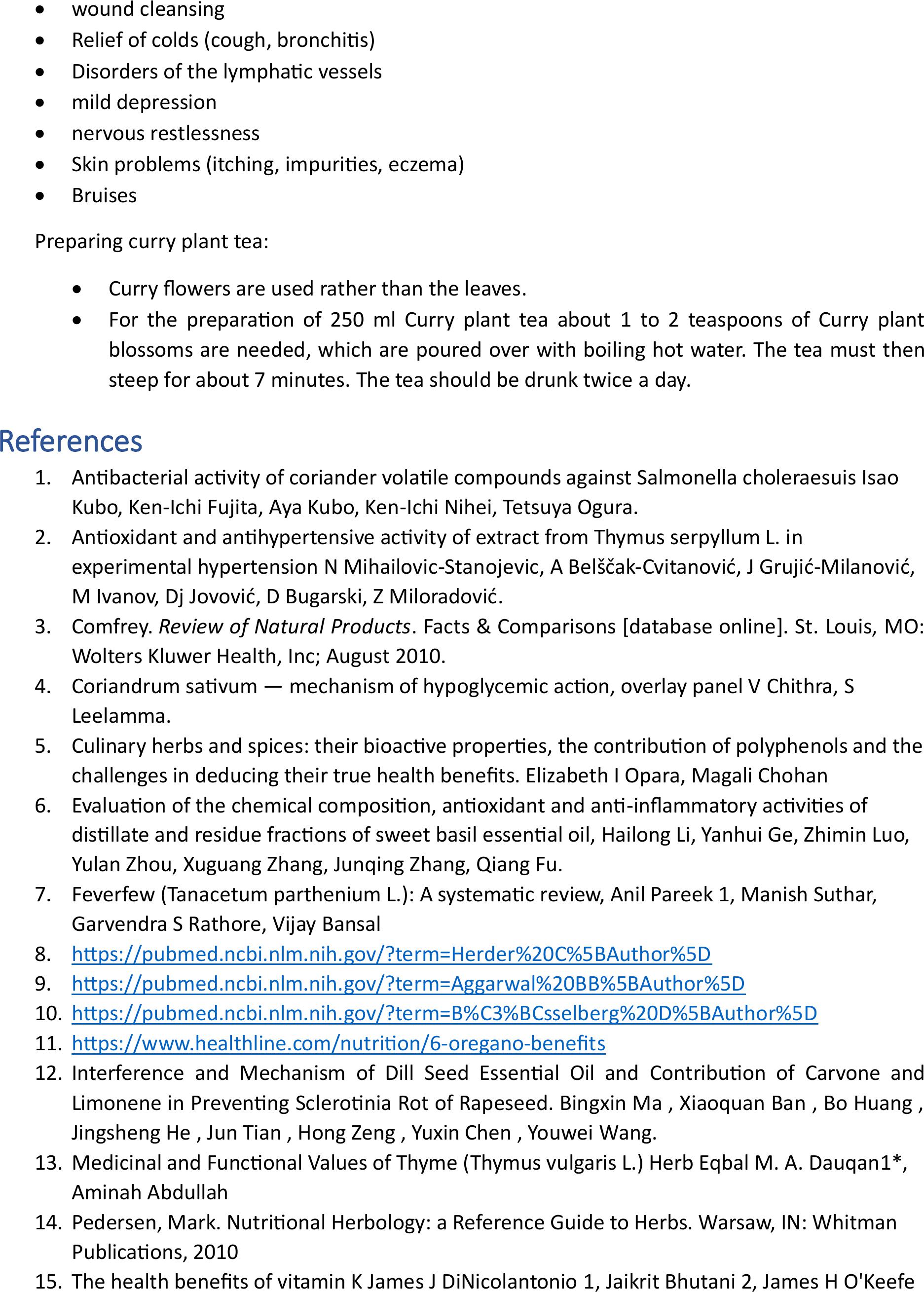
•wound cleansing
•Relief of colds (cough, bronchis)
•Disorders of the lymphac vessels
•mild depression
•nervous restlessness
•Skin problems (itching, impuries, eczema)
•Bruises
Preparing curry plant tea:
•Curry owers are used rather than the leaves.
•For the preparaon of 250 ml Curry plant tea about 1 to 2 teaspoons of Curry plant
blossoms are needed, which are poured over with boilinghot water. The tea must then
steep for about 7 minutes.The tea should be drunk twice a day.
References
1.Anbacterial acvity of coriander volale compounds against Salmonella choleraesuis Isao
Kubo, Ken-Ichi Fujita, Aya Kubo, Ken-Ichi Nihei, Tetsuya Ogura.
2.Anoxidant and anhypertensive acvity of extract from Thymus serpyllum L. in
experimental hypertension N Mihailovic-Stanojevic, A Belščak-Cvitanović, J Grujić-Milanović,
M Ivanov, Dj Jovović, D Bugarski, Z Miloradović.
3.Comfrey.Review of Natural Products. Facts & Comparisons [database online]. St. Louis, MO:
Wolters Kluwer Health, Inc; August 2010.
4.Coriandrum savum — mechanism of hypoglycemic acon, overlay panel V Chithra, S
Leelamma.
5.Culinary herbs and spices: their bioacve properes, the contribuon of polyphenols and the
challenges in deducing their true health benets. Elizabeth I Opara, Magali Chohan
6.Evaluaon of the chemical composion, anoxidant andan-inammatory acvies of
disllate and residue fracons of sweet basil essenal oil, Hailong Li, Yanhui Ge, Zhimin Luo,
Yulan Zhou, Xuguang Zhang, Junqing Zhang, Qiang Fu.
7.Feverfew (Tanacetum parthenium L.): A systemac review, Anil Pareek 1, Manish Suthar,
Garvendra S Rathore, Vijay Bansal
8.hps://pubmed.ncbi.nlm.nih.gov/?term=Herder%20C%5BAuthor%5D
9.hps://pubmed.ncbi.nlm.nih.gov/?term=Aggarwal%20BB%5BAuthor%5D
10.hps://pubmed.ncbi.nlm.nih.gov/?term=B%C3%BCsselberg%20D%5BAuthor%5D
11.hps://www.healthline.com/nutrion/6-oregano-benets
12.Interference and Mechanism of Dill Seed Essenal Oil and Contribuon of Carvone and
Limonene in Prevenng Scleronia Rot of Rapeseed. Bingxin Ma , Xiaoquan Ban , Bo Huang ,
Jingsheng He , Jun Tian , Hong Zeng , Yuxin Chen , Youwei Wang.
13.Medicinal and Funconal Values of Thyme (Thymus vulgaris L.) Herb Eqbal M. A. Dauqan1*,
Aminah Abdullah
14.Pedersen, Mark. Nutrional Herbology: a Reference Guide to Herbs. Warsaw, IN: Whitman
Publicaons, 2010
15.The health benets of vitamin K James J DiNicolantonio 1, Jaikrit Bhutani 2, James H O'Keefe